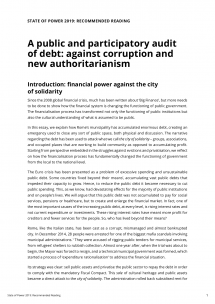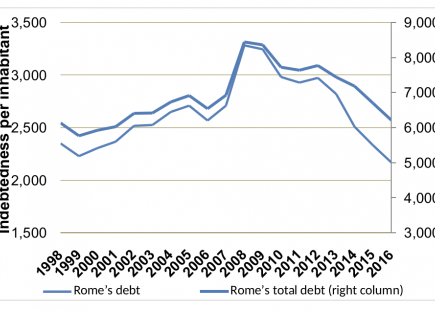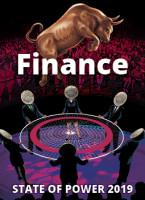Rome: financial power against a city of solidarity
Topics
Regions
Rome’s municipality has accumulated enormous debt, creating an emergency used to close any sort of public space, both physical and discussion. The narrative regarding the debt has been used to attack what we call the city of solidarity – groups, associations, and occupied places that are working to build community as opposed to accumulating profit.

Downloads
Authors
Since the 2008 global financial crisis, much has been written about ‘Big Finance’, but more needs to be done to show how the financial system is changing the functioning of public government. The financialisation process has transformed not only the functioning of public institutions but also the cultural understanding of what is assumed to be public.
Rome’s municipality has many lessons for social movements confronting financial power. Its accumulation of enormous debts in the last decade has created an emergency used to close any sort of public space, both physical and discussion. The crisis came to a head with the arrest in December 2014 of 28 people for one of the biggest mafia scandals involving municipal administrations. They were accused of rigging public tenders for municipal services, from refugees’ shelters to rubbish collection. This created an excuse for the imposition of a technocratic municipal government, which started a process of ‘expenditure rationalisation’ to address the financial situation. What it ignored were the root causes of both the debt and the corruption which was the financialisation of these cities.
Instead the debt crisis provided the logic for deepening a neoliberal path. Their strategy was clear: sell public assets and privatise the public sector to repay the debt in order to comply with the mandatory Fiscal Compact. This sale of cultural heritage and public assets became a direct attack to the city of solidarity. The administration rolled back subsidised rent for associations or social spaces, recognised in previous years for the value of their cultural, social or political activity in the city. Around December 2015, many self-organised social centres and associations started to receive fines for the unpaid additional monthly rent that they had been charged at the market rate, and issued with an eviction order.
Under the common slogan ‘Rome is not for sale’ a campaign was launched, with different assemblies and a demonstration where 20,000 people took to the streets of Rome on 19 March 2016. The Decide Roma (Rome Decides) network was set up to map the different spaces under attack and organise their resistance. The goal was to write the Charter of the commons of the city of Rome, to safeguard the urban commons and open a space to experiment on autonomous institutionalism.
Video launching the demonstration of 19 March 2016 (in Italian)
The network also decided to put the focus on examining the debt and corruption, as this was being used as the main tool to evict, sell and privatise social centres, associations and public spaces. Decide Roma set up a working group to conduct a public and participatory audit. The project for a participatory audit drew on similar experiences, such as the Committee for the Abolition of the Illegitimate Debt and the Spanish network Mac.
The working group had a diverse composition who could understand legislation and budgets and met on average every week alongside the Decide Roma plenary. In May 2016, the working group presented the first report on Rome’s debt to foster a public debate on the local debt and campaign for a public and participatory audit. The report was discussed in public assemblies, printed, and became an integral part of the Decide Roma debates.
Video on the report launching the demonstration of 6 May 2017 (in Italian)
The report showed that enormous debts incurred by the municipality of Rome could not be separated from the broader Italian and European context. Italy accumulated a colossal debt between the 1970s and 1980s, when many governments facing the economic crisis turned towards expansive fiscal policies, operating in financial deficit for years. This combined with low capacity to collect taxes, and loss of control over public debt by sovereign national entities (the National Central Bank and the Treasury) led Italy to become increasingly dependent on the global financial market for loans.
Accompanying this in the 1990s, a first round of austerity measures was enacted to meet the Maastricht criteria, and a broad process of privatisation and selling of public assets started. This process went on at all state levels, involving municipalities through the devolution process. Municipalities acquired fiscal autonomy; direct management of local services; possibility of operating in deficit; access to private financial markets; capacity to issue bonds and enter into financial contracts; and the possibility to use private capital for public works (public–private partnerships, or PPPs). These new competences underpin the financialisation process of the Italian municipalities.
Meanwhile, the Bank for Savings and Credit (Cassa Depositi e Prestiti, CDP), the postal savings bank, which used to finance municipalities with low interest rates, was privatised in 2003. From then on, the municipalities had to emit private bonds on the international financial market and develop derivative contracts to fund themselves.
Figure 1. Rome’s per capita debt and total debt

Rome is a ‘bad investment’
The financialisation process of Rome’s municipality has not just meant rising public debt but also the outsourcing of services or their management following market criteria. The two phenomena are related and mutually reinforcing. This process of outsourcing has involved a large part of the public sector, being sub-contracted to other private companies or cooperatives. This process has led to corruption and mafia infiltration. In fact, this is what the ‘Mafia Capitale’ scandal was about, a small clan who used illegal methods to win public tenders and contracts to manage migrant-holding facilities, Roma camps and rubbish collection.
It has also had social and environmental costs. In Rome, the water and energy services are provided by ACEA S.p.A., a multi-utility company. The municipal share is about 51 per cent, the other major shareholder is the French multinational Suez and a company linked to the Italian building contractor Caltagirone. The company follows market criteria, ignoring residents’ right to water, for example cutting off water to consumers who are unable to pay their bills.
A series of scandals related to these services have been used to undermine the general sense of what is public, opening the space for new privatisation. Decide Roma has sought instead to reopen a discussion about what is public and how to manage them in a participatory way.
The Decide Roma network and its working group for a public and participatory audit have had confront strong obstacles. The city government elected in June 2016 after the technocratic administration - and its Mayor, Virgina Raggi from the Movimento Cinque Stelle (Five Stars Movement) - have refused public discussion on local finance or the idea of a public audit. They have also refused to recognise Decide Roma as an interlocutor, despite campaigning on a platform of new participation tools and democracy from below. State secrecy over the debt has also impeded a complete audit on the debt, because there is no detailed information on the creditors and the terms of the contracts. Even the city council is unable to retrace the list of its own creditors, with a parliamentary hearing in April 2016 recording that ‘the Municipality is unable to trace the creditors for the 43% of its commercial debt’.
The impossibility of influencing any institutional decisions or even having any formal or informal channel of communication with the City Council has weakened Decide Roma’s public voice. Many activists are now working on a campaign for the public ownership of Cassa Depositi e Prestiti to reclaim transparency on local investments and voice on urban development.
Nevertheless, this militant inquiry on Rome’s municipal debt has revealed how the debt has been used as a tool to create an emergency and ultimately limited the democratic functioning of public institutions. The case of Rome has showed how rising public debt is not related to rising current expenditures. Instead it has revealed an overturning of the political use of public debt: from a public debt used for welfare, social services and infrastructure, to one used to create and enlarge the financial market. This means that we have to open up ‘the black box’ of public debt and ask how the debt is composed and how it was contracted.
In Rome, both the period of debt accumulation and the period of its Commissioner’s management, have been coupled with corruption, clientelism, and deteriorating local services and infrastructure. This never-ending debt emergency is now coupled with the narrative of a ‘security and migration emergency’ at the local and national level. The debt has been a tool to construct a privatised and fearful city, a city where there are no opportunities for discussion with public institutions, and where all the self-organised meeting places are under threat of evictions and closure. Against this, we have to reclaim back a city for all, a city of solidarity, where no-one is alone.
This article is an excerpt. Download the PDF for the full essay.
